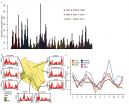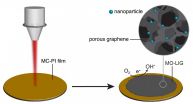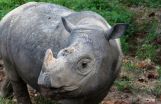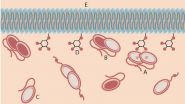(Press-News.org) PRINCETON, N.J.--Tracking mobile phone data is often associated with privacy issues, but these vast datasets could be the key to understanding how infectious diseases are spread seasonally, according to a study published in the Proceedings of the National Academy of Sciences.
Princeton University and Harvard University researchers used anonymous mobile phone records for more than 15 million people to track the spread of rubella in Kenya and were able to quantitatively show for the first time that mobile phone data can predict seasonal disease patterns.
Harnessing mobile phone data in this way could help policymakers guide and evaluate health interventions like the timing of vaccinations and school closings, the researchers said. The researchers' methodology also could apply to a number of seasonally transmitted diseases such as the flu and measles.
"One of the unique opportunities of mobile phone data is the ability to understand how travel patterns change over time," said lead author C. Jessica Metcalf, assistant professor of ecology and evolutionary biology and public affairs at Princeton's Woodrow Wilson School of Public and International Affairs. "And rubella is a well-known seasonal disease that has been hypothesized to be driven by human population dynamics, making it a good system for us to test."
"The potential of mobile phone data for quantifying mobility patterns has only been appreciated in the last few years, with methods pioneered by authors on this paper," said lead author Amy Wesolowski, a postdoctoral fellow at Harvard's School of Public Health. "It is a natural extension to look at seasonal travel using these data."
In the past, it was difficult to collect data on individuals in low-income and undeveloped countries due to a lack of technology usage. But mobile phone ownership, especially in these areas, is rapidly increasing, producing large and complex datasets on millions of people. Because of the mobility of cellphones, it is possible that phone records could predict certain health-related patterns. This spurred the researchers to take a closer look.
Ultimately, the research team wanted to see whether cellphone users and their movement around the country could predict the seasonal spread of rubella. The researchers used available records to analyze mobile phone usage and movement between June 2008 and June 2009 for more than 15 million cellphone users in Kenya. (Note: February 2009 was missing from the dataset.)
Using the location of the routing tower and the timing of each call and text message, the researchers were able to determine a daily location for each user as well as the number of trips these users took between the provinces each day. In total, more than 12 billion mobile phone communications were recorded anonymously and linked to a province.
The researchers then compared the cellphone analysis with a highly detailed dataset on rubella incidence in Kenya. They matched; the cell phone movement patterns lined up with the rubella incidence figures. In both of their analyses, rubella spiked three times a year: September and February primarily, and, in a few locations, rubella peaked again in May. This showed the researchers that cellphone movement can be a predictor of infectious-disease spread.
Overall, the results were in line with the researchers' predictions; rubella is more likely to spread when children interact with one another at the start of school and after holiday breaks. Across most of the country, this risk then decreases throughout the rest of the school-term months. (The only anomaly was in Western Kenya where the risk during school breaks was relatively higher than when school was in session; the data were insufficient to clearly indicate why.)
"Our analysis shows that mobile phone data may be used to capture seasonal human movement patterns that are relevant for understanding childhood infectious diseases," Metcalf said. "In particular, phone data can describe within-country movement patterns on a large scale, which could be especially helpful for localized treatment."
The results highlight how mobile phone data could be a powerful tool for understanding the critical drivers of epidemics. The researchers hope to next apply their methodology to measles and other infections shaped by human movement like malaria and cholera.
Additional co-authors include Bryan Grenfell, Princeton's Kathryn Briger and Sarah Fenton Professor of Ecology and Evolutionary Biology and Public Affairs; Nathan Eagle and Caroline Buckee from the Harvard School of Public Health; Janeth Kombich from the University of Kabianga in Kenya; Ottar Bjornstad from Pennsylvania State University; Justin Lessler from Johns Hopkins Bloomberg School of Public Health; and Andrew Tatem from the University of Southampton in the United Kingdom.
INFORMATION:
The paper, "Quantifying seasonal population fluxes driving rubella transmission dynamics using mobile phone data," was published online Aug. 17.
This work was supported by the National Science Foundation, the James S. McDonnell Foundation, the Bill and Melinda Gates Foundation, the National Institutes of Health, the Department of Homeland Security, the Fogarty International Center, the Models of Infectious Disease Agent Study program and the Wellcome Trust Sustaining Health Grant.
Glenview, Ill. (August 20, 2015)--The popularity of electronic cigarettes has steadily increased worldwide, but little is known about their effects on health. New research suggests that the single use of an electronic cigarette approximating the nicotine exposure of one tobacco cigarette reduces the sensitivity of the cough reflex.
The study tested 30 adult lifetime nonsmokers with no history of asthma or respiratory diseases and used cough tests to determine how e-cigarettes affect the cough reflex. Capsaicin, the pungent extract of red peppers, was used to induce a ...
Medicaid is expected to save billions of dollars a year as patents for several blockbuster antipsychotic medications expire and use of generic versions of these drugs increases, according to a new study by researchers at the University of Maryland School of Medicine. These savings may provide relief from the high costs of these medications and allow policymakers to lift restrictions on patients' access, the researchers argue.
The study forecast that annual Medicaid payments for antipsychotic medicines will decrease by nearly $1.8 billion (or nearly 50 percent) by 2016 ...
HOUSTON - (Aug. 20, 2015) - Rice University chemists who developed a unique form of graphene have found a way to embed metallic nanoparticles that turn the material into a useful catalyst for fuel cells and other applications.
Laser-induced graphene, created by the Rice lab of chemist James Tour last year, is a flexible film with a surface of porous graphene made by exposing a common plastic known as polyimide to a commercial laser-scribing beam. The researchers have now found a way to enhance the product with reactive metals.
The research appears this month in the ...
Leading scientists and experts in the field of rhino conservation state in a new paper that it is safe to consider the Sumatran rhinoceros extinct in the wild in Malaysia. The survival of the Sumatran rhino now depends on the 100 or fewer remaining individuals in the wild in Indonesia and the nine rhinos in captivity.
Despite intensive survey efforts, there have been no signs of the wild Sumatran rhinoceros (Dicerorhinus sumatrensis) in Malaysia since 2007, apart from two females that were captured for breeding purposes in 2011 and 2014. Scientists now consider the species ...
An international team of scientists headed by biologists at UC San Diego has discovered that an important class of stem cells known as human "induced pluripotent stem cells," or iPSCs, which are derived from an individual's own cells, can be differentiated into various types of functional cells with different fates of immune rejection.
The scientists also found that these cells may not be rejected by the immune system if iPSCs are turned into retinal pigment epithelium cells destined for the eye.
Their discovery provides hope for the development of human stem cell therapies ...
A team of Swiss geneticists from the University of Geneva (UNIGE), the École Polytechnique Fédérale de Lausanne (EPFL), and the University of Lausanne (UNIL) discovered that genetic variation has the potential to affect the state of the genome at many, seemingly separated, positions and thus modulate gene activity, much like a conductor directing the performers of a musical ensemble to play in harmony. These unexpected results, published in Cell, reveal the versatility of genome regulation and offer insights into the way it is orchestrated.
Chromatin, a ...
An international group of researchers led by Carnegie Mellon University physicists Mathias Lösche and Frank Heinrich have established the structure of an important tumor suppressing protein, PTEN. Their findings provide new insights into how the protein regulates cell growth and how mutations in the gene that encodes the protein can lead to cancer. The study is published online in Structure, and will appear in the Oct. 6 issue.
Phosphatase and tensin homolog (PTEN) is a known tumor suppressing protein that is encoded by the PTEN gene. When expressed normally, the ...
The hippocampus in the brain's temporal lobe is responsible for more than just long-term memory. Researchers have for the first time demonstrated that it is also involved in quick and successful conflict resolution. The team headed by Prof Dr Nikolai Axmacher from the Ruhr-Universität Bochum (RUB), together with colleagues from the University Hospital of Bonn as well as in Aachen and Birmingham, reported in the journal "Current Biology".
Decision conflicts occur often in everyday life
In their everyday life, people are constantly confronted with decision conflicts, ...
Researchers estimate the 20-year breast cancer-specific death rate for women diagnosed with ductal carcinoma in situ to be 3.3 percent, although the death rate is higher for women diagnosed before age 35 and for black women, according to an article published online by JAMA Oncology.
Ductal carcinoma in situ breast (DCIS) cancer, which is also referred to as stage 0 breast cancer, accounts for about 20 percent of the breast cancers detected through mammography. Some women with DCIS experience a second breast cancer (DCIS or invasive) and a small proportion of patients ...
People with psychopathic characteristics are less likely to be affected by "contagious yawning" than those who are empathetic, according to a Baylor University psychology study.
Yawning after spotting someone else yawn is associated with empathy and bonding, and "catching" yawns happens with many social mammals, among them humans, chimpanzees and dogs, researchers say.
The study -- "Contagious yawning and psychopathy" -- involved 135 college student respondents and was published online in the journal Personality and Individual Differences.
"You may yawn, even if you ...




